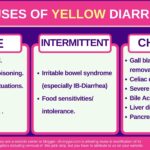5 Main Causes of Lack of Bile in Stool.
Our content is not intended nor recommended as a substitute for medical advice by your doctor. Use for informational purposes only.
The lack of bile in the stool often results from diseases affecting the liver or obstructing the bile ducts. However, a healthy person’s stool decrease or lack of bile is unlikely.
A change in the stool color into pale, grey, or clay color doesn’t always mean a lack of bile. Other causes of pale stool will be explained later in the article.
The most common causes of lack of bile in the stool include:
- A gallstone obstructing the common bile duct.
- Acute hepatitis.
- Drug-indued cholestasis.
- Late stages of liver cell failure.
- Tumors block the biliary system.
- Biliary stricture.
- Other less common conditions include primary biliary cholangitis, sclerosing cholangitis, and bile duct ligation during surgery.
Table of Contents
1 . Gallstones obstructing the CBD.
Gallstones are small stones (often made of cholesterol) that form inside the gallbladder.
The gallbladder secretes its bile contents bile to the duodenum through the common bile duct. Bile then travels through the intestine and the colon to be reabsorbed or passed into the stool.
Some of the gallstones inside may slip into the common bile duct, get stuck, and prevent the bile flow into the intestine.
The case is called (calcular obstructive jaundice or choledocholithiasis). And it is one of the commonest causes of the lack of bile in your stool.
Symptoms:
- Typical biliary colic (severe upper right abdominal pain, dull aching).
- The pain lasts at least 30 minutes. However, it may become prolonged for up to 6 hours or more.
- The pain may radiate to the back or the right shoulder.
- Associated with severe nausea with or without vomiting.
- Jaundice often develops (yellowish skin and eye whites).
- The lack of bile in stool gives it characteristic pale or clay color.
- The urine is often dark or tea-colored.
- If the stone passes into the duodenum after a while, The pain and jaundice resolve. And the stool regains its standard brown color.
- Sometimes, complications occur, such as cholangitis (inflammation of the biliary tract with fever and pain) or pancreatitis (inflammation of the pancreas).
The asymptomatic clay-colored stool is unlikely to be due to biliary obstruction (jaundice, dark urine, and pain often present).
The diagnosis of bile duct stones is often made by abdominal imaging (abdominal ultrasound or a particular type of MRI called (MRCP).
The treatment is often by removing the stone using a technique called (Endoscopic Retrograde Cholangio-Pancreatography ERCP). The ERCP is done by your gastroenterologist using a specialized endoscope.
2. Acute hepatitis.
Acute inflammation of the liver is common. The inflamed liver tissue may fail to excrete bile into the gallbladder and the intestine. This leads to jaundice and lack of bile in the stool in severe cases.
Common causes of acute hepatitis include:
- Viral infections such as acute hepatitis A, Acute hepatitis B, CMV (Cytomegalovirus) hepatitis, and EBV (Epstein-Barr Virus) hepatitis.
- Drugs such as acetaminophen for hepatitis.
- Autoimmune hepatitis.
- Pregnancy-related diseases such as Preeclampsia, Acute fatty liver of pregnancy, or HELLP syndrome.
- Low blood pressure (ischemic hepatitis).
- And others.
Symptoms of acute hepatitis include:
- Mild (dull) aching pain or tenderness in the right upper quadrant of the abdomen.
- Jaundice (yellow skin and eye whites).
- Clay or pale-colored stool due to the lack of bile.
- Dark (tea or cola-colored) urine.
- Sometimes diffuse abdominal pain.
- With acute hepatitis A, nausea, vomiting, and diarrhea may also occur.
- Body aches and fatigue.
Your doctor will confirm the diagnosis of acute hepatitis as a cause of lack of bile in the stool by laboratory tests (elevated liver enzymes and bilirubin levels).
Investigations for the cause also help, such as testing for hepatitis A or B.
3. Late-stage liver cirrhosis.
Patients with acute liver cell failure (fulminant hepatitis) or chronic liver cells failure (decompensated liver cirrhosis) may suffer a lack of bile in their stool.
Bile is originally formed inside the liver cells and is released into the stool. However, during the late stages of liver cirrhosis, the cells can no longer produce enough bile, leading to a lack of bile in stool.
Symptoms of endstage liver disease:
- Jaundice.
- Swelling of the lower limbs.
- Swelling of the abdomen (ascites).
- Muscle wasting.
- Fatigue and weakness.
- In late cases, confusion and loss of consciousness may occur.
4. Tumors obstructing the biliary system.
Tumors may cause mechanical obstruction of the bile ducts with subsequent lack of bile in your stool.
Common tumors include:
- Cancer head of the pancreas (it blocks the terminal part of the bile duct just before its duodenal end.
- Tumor of the biliary ducts (cholangiocarcinoma).
- Large-sized liver tumor (primary liver cancer).
- Multiple large-sized liver metastases.
5. Drug-induced cholestasis.
Many medications can cause direct injury to the liver. The pattern of affection of the liver by drugs can be.
The drugs can induce liver inflammation, cholestasis (bile stasis), or both.
Common medications that may cause cholestasis with a lack of bile in the stool:
- Some antibiotics, such as penicillins.
- Some antihistaminics such as Cimetidine.
- Birth control pills.
- Gold salts.
- Imipramine.
- Anabolic steroids.
- Chlorprmaziene and others.
6. Others.
- Bile duct strictures (narrowing).
- Rare biliary system diseases such as primary biliary cholangitis and sclerosing cholangitis.
- Alcohol-induced liver injury.
- Nonalcoholic steatohepatitis.
- Wilson’s disease.
- Liver cysts.
FAQs about lack of bile in stool:
What does a lack of bile in stool look like?
The stool without bile loses its standard brown color and becomes pale or clay-colored. The lack of bile may also cause the stool to be loose or watery due to unabsorbed fat.
What does lack of bile mean?
Lack of bile in the stool means that bile can no longer reach your digestive tract to pass with the stool. Causes include obstruction of the bile ducts with a stone or tumor and severe liver diseases such as acute hepatitis or liver failure.
How do you increase bile in stool?
There is no definite way to increase bile in the stool if you are healthy. But if you lack bile in the stool due to a disease, the only way to increase bile in the stool is by treating the original disease.
For example, removing the stone and constructing the bile duct will make bile increase in the stool again.
What color is low bile stool?
The color of low bile stools is often grey, pale, or whitish. The stool that loses its normal brown color due to lack of bile is also known as clay-colored stool.
When to see a doctor for the lack of bile in stool?
See a doctor when there are:
- Very pale or whitish stool for several days without apparent cause (even without other symptoms).
- Presence of jaundice (yellow skin and eye whites.
- Itching.
- Fever.
- Severe diarrhea.
- Severe pain in the upper-right or upper-middle abdomen.
- Persistent nausea or vomiting.
- Fever.
- Dark urine.
- Evidence-based
- Written by a doctor.

Related Posts:
- Does the pancreas Produce bile? & Why bilirubin is…
- Bloated as Pregnant? 6 Main Causes & Treatments.
- 5 Main causes of abdominal pain and blood in the urine
- Clear Urine with Bubbles: 6 Main Causes & When to Worry
- Tea-colored Urine: 5 Main Causes & When to Worry
- Pancreas Problems: 5 Main Conditions, Symptoms, & Signs






